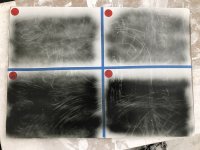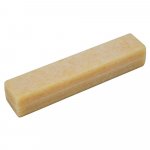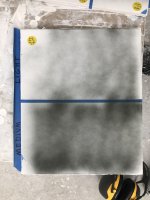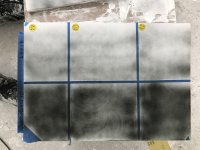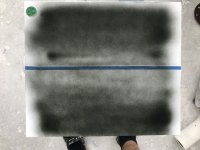Hi Everyone,
This is my first post on the forum. Hopefully you guys can give me some ideas as to troubleshooting this sanding issue I'm having -- it's been a real headache.
I work in a studio finishing fine art painting panel surfaces for an artist that uses airbrush. Airbrushes tends to show every imperfection in the panel surface so the task is somewhat tedious. The panels are constructed with gator board sheets inset into a poplar frame and backing support. They look very similar to standard painting stretcher bars but the canvas is permanently affixed to the panel and the canvas stays much more taut than a stretcher.
The Problem
When I'm sanding, I'm getting these ghost embossed type swirl marks all over the panel surface that show up once the artist starts painting. They are not scratches as far as I can tell, more like pressure marks caused by sanded balls of gesso being trapped between the sand paper and the surface which are rubbed or ground into the face of the work piece.
The Process:
The canvas is primed and a rubbery paste is applied to eliminate canvas texture and then gesso'd over using a Graco industrial paint sprayer. We then sand with Festools Granat sandpaper, ETS 150/3 sander (intensity 3-6) with a hard pad and a CT 48 on low setting moving very slowly across the surface (1"/sec) in a linear fashion with little or no pressure on the sander until the surface has been evenly covered. We generally start at 150 grit as the surface is relatively level after the spray layers and 80 / 100 / 120 is a bit aggressive and tends to leave deep scratch marks on the soft gesso layer . Our prep procedure is as follows:
Spray Prime Gesso - 8 - 9 coats
Skim coat - 3 layers to even out the orange peel surface left by the sprayer, prior to sanding
150 - Sanding the face but avoiding the outer edges to prevent burning through the paint.
220 - Sanding the face but avoiding the outer edges to prevent burning through the paint)
320 - Covering the entire surface. At this point the gesso is very even but ghosting swirls are appearing from the gesso corning on the sanding disks despite diligence and attention to keeping the paper very clean and changing it every 1.5 - 2 min.
Skim coat 2 layers to fill in any scratches created by 150 that haven't been remedied
400 - Ghost swirls / pigtails what have you are still apparent and occurring with each pass of the sander. They're more abrasions or emboss marks caused by waste sanded material getting trapped between the paper and the painting surface and being ground into the panel.
500 - "Same"
800 - "Same"
______________________
As soon as the artist starts painting, the swirls start showing up on the surface. I'd really like to eliminate this from happening.
It doesn't seem like going up in grit is lessening the problem, the swirls are just as prominent at 320 as they are at 1200. I've tried moving very slowly , fast, high vacuum , low vacuum, high medium intensity, switching the paper very very frequently. I never let the gesso waste on the paper accumulate past a couple scattered dots when using the ETS 150 but I guess it's enough to leave marks. Any help with this issue would be amazing as it's causing me a lot of frustration. Thanks for any tips or suggestions!
d
*** For some reason I can't seem to post images to my topics. If you'd like I can DM or PM images of the errors that are occurring. ***
This is my first post on the forum. Hopefully you guys can give me some ideas as to troubleshooting this sanding issue I'm having -- it's been a real headache.
I work in a studio finishing fine art painting panel surfaces for an artist that uses airbrush. Airbrushes tends to show every imperfection in the panel surface so the task is somewhat tedious. The panels are constructed with gator board sheets inset into a poplar frame and backing support. They look very similar to standard painting stretcher bars but the canvas is permanently affixed to the panel and the canvas stays much more taut than a stretcher.
The Problem
When I'm sanding, I'm getting these ghost embossed type swirl marks all over the panel surface that show up once the artist starts painting. They are not scratches as far as I can tell, more like pressure marks caused by sanded balls of gesso being trapped between the sand paper and the surface which are rubbed or ground into the face of the work piece.
The Process:
The canvas is primed and a rubbery paste is applied to eliminate canvas texture and then gesso'd over using a Graco industrial paint sprayer. We then sand with Festools Granat sandpaper, ETS 150/3 sander (intensity 3-6) with a hard pad and a CT 48 on low setting moving very slowly across the surface (1"/sec) in a linear fashion with little or no pressure on the sander until the surface has been evenly covered. We generally start at 150 grit as the surface is relatively level after the spray layers and 80 / 100 / 120 is a bit aggressive and tends to leave deep scratch marks on the soft gesso layer . Our prep procedure is as follows:
Spray Prime Gesso - 8 - 9 coats
Skim coat - 3 layers to even out the orange peel surface left by the sprayer, prior to sanding
150 - Sanding the face but avoiding the outer edges to prevent burning through the paint.
220 - Sanding the face but avoiding the outer edges to prevent burning through the paint)
320 - Covering the entire surface. At this point the gesso is very even but ghosting swirls are appearing from the gesso corning on the sanding disks despite diligence and attention to keeping the paper very clean and changing it every 1.5 - 2 min.
Skim coat 2 layers to fill in any scratches created by 150 that haven't been remedied
400 - Ghost swirls / pigtails what have you are still apparent and occurring with each pass of the sander. They're more abrasions or emboss marks caused by waste sanded material getting trapped between the paper and the painting surface and being ground into the panel.
500 - "Same"
800 - "Same"
______________________
As soon as the artist starts painting, the swirls start showing up on the surface. I'd really like to eliminate this from happening.
It doesn't seem like going up in grit is lessening the problem, the swirls are just as prominent at 320 as they are at 1200. I've tried moving very slowly , fast, high vacuum , low vacuum, high medium intensity, switching the paper very very frequently. I never let the gesso waste on the paper accumulate past a couple scattered dots when using the ETS 150 but I guess it's enough to leave marks. Any help with this issue would be amazing as it's causing me a lot of frustration. Thanks for any tips or suggestions!
d
*** For some reason I can't seem to post images to my topics. If you'd like I can DM or PM images of the errors that are occurring. ***

